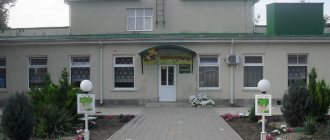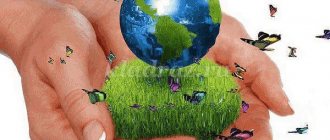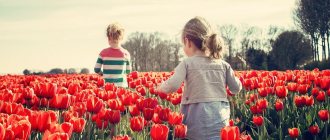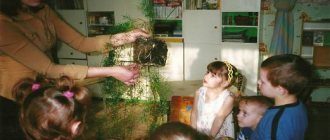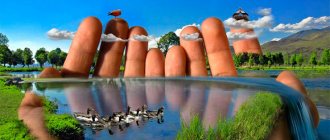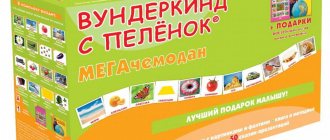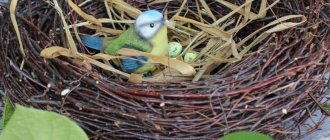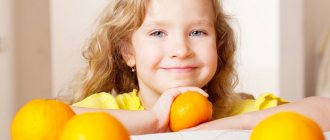Definition of the concept of environmental education
Environmental education is the inculcation of moral categories that are responsible for developing a caring attitude towards the environment in a person.
Environmental education should begin from preschool age, since it is at this moment that a person develops a set of basic moral values. Note 1
As part of environmental education, the child becomes familiar with the basic concepts of nature, realizes that he is part of this nature, and that people are responsible for almost everything that happens on our planet. The child must learn to take care of the environment. These goals and objectives are precisely realized within the framework of environmental education.
Are you an expert in this subject area? We invite you to become the author of the Directory Working Conditions
Organization of the subject-game environment
To implement the objectives of the program, a subject-development environment is formed in a preschool institution, the purpose of which is to awaken the child’s interest in the world around him, the desire to know it and take part in its formation.
The environmental center includes indoor plants, their passports with a graphic depiction of methods of care, frequency of watering, method of reproduction, and light-loving behavior. The list of plants for each age of children is determined by the curriculum.
Here are tools for loosening the soil, replanting, cutting, spraying and watering plants. For preschoolers to work, aprons are purchased with the expectation that there will be at least 5 people in the group. While working in an indoor flower garden, children observe the growth of flowers, make simple conclusions about the process of plant formation, and determine the decisive factors in changing the height, shape, color of leaves, and the formation of buds.
Nearby you can place a mini-garden with onions, parsley, dill, and berries. It can be designed in the form of a train, a fairy-tale meadow, or cartoon characters. By observing the development and growth of plantings, preschoolers become familiar with their beneficial properties, method of consumption and set of vitamins.
In the ecological center there can be a living corner with 2-3 representatives of fauna: a hamster, a mouse, a guinea pig, a parrot. The kids' tasks include caring for their pets on a daily basis. The guys understand that without their care, the inhabitants of the corner could die. Meanwhile, being in the group with them is fun and cozy. An activity-game with pets teaches preschoolers and schoolchildren empathy, a reverent attitude towards them, and observation of how pets grow and take care of themselves.
The cognitive and practical center in the group involves elements of research activity in the concept of “ecological education”; it is a mini-laboratory for games and work with children to develop their own projects, hypotheses, and discoveries.
Such a center can be equipped with a microscope, mirrors, flasks, liquids for mixing, and lenses. By studying a leaf, grain, or fluff under a magnifying glass, children become familiar with the structure of the object, its density, and color scheme. This is a good way, using the possibilities of play, to cultivate perseverance, observation, and develop the analytical abilities of preschoolers and schoolchildren.
Thematic environmental stations are organized on playgrounds with the aim of studying objects of living and inanimate nature.
Ecology for children also includes the stations “Forest”, “Flower Garden”, “Vegetable Garden”, “Meadow”, “Field”, “Pond”, “People’s Pharmacy”, which would be more appropriate to equip on the territory of the kindergarten near the playground.
Here the children observe the flora of their region and learn how to care for vegetable crops in open ground conditions. Signs with pictures of vegetables will serve as a guide for observing and working in your garden. Two or three pines and several spruce trees will create a small forest corner where you can observe the growth of trees, the appearance of young shoots on the branches, study the cones of coniferous trees and find their differences.
A small area of unmown grass will be a good imitation of a meadow, where preschoolers will observe the life and behavior of insects, beetles, and worms. And the sown wheat, rye, and barley will allow you to form an idea about the origin of bread and teach you how to treat it with care. On an artificial pond, children can observe the plants of the reservoir: water lily, duckweed, reeds, sedge. Snails and small fish should be released into the depths of the mini-reservoir. Butterflies and dragonflies will choose a place to rest here.
Functional ecological stations include the “Bird Canteen”, “Meteorological Station”, “Skillful Hands”.
In them, children learn to compose the simplest chains of ecology, determine the direction and strength of wind movement, and the weather. Here, using natural and waste materials, preschoolers are engaged in making crafts, testing wood, stems, and cones for strength, flexibility, and fragility. Games at stations help develop children's thinking processes, moral qualities, and fine motor skills.
Prohibitory signs located at stations, in the form of a game, will reinforce children’s knowledge of the rules of behavior in nature, teach them to appreciate the ecology of their region, and help bring the environmental education of preschoolers into line with the requirements of the curriculum.
Forms of environmental education
There are the following forms of environmental education:
- educational activities
- excursions
- themed holidays
- getting to know nature in everyday life
- work activity
- exhibitions, competitions, olympiads
Educational activities are the leading method of introducing students to nature and the surrounding world. In the process of educational activities, the teacher systematically provides knowledge about natural phenomena and objects to children, taking into account their age, psychological characteristics and the specifics of the area in which the children live.
Classes can have several varieties:
- introductory lessons
- generalizing lessons
- in-depth educational lessons
During introductory lessons, students can become familiar with different species of animals, plants and natural phenomena that are not found in their area. During the lesson, the teacher uses a large number of visual aids. They help students develop correct ideas about the topic of the lesson.
Finished works on a similar topic
Course work Methods and forms of environmental education 410 ₽ Abstract Methods and forms of environmental education 220 ₽ Examination Methods and forms of environmental education 230 ₽
Receive completed work or specialist advice on your educational project Find out the cost
During a generalization lesson, children learn to generalize their knowledge regarding certain natural phenomena and objects. During this lesson, children learn to analyze, compare, and generalize.
During an in-depth cognitive lesson, children expand their knowledge of the phenomena that they see every day in everyday life. The teacher supplements the existing information with new information.
Excursions occupy a special place in the process of environmental education. During excursion lessons, children can get acquainted with natural phenomena in a natural setting. It is advisable to conduct excursions to the same places at different times of the year so that children can notice seasonal natural changes.
Themed holidays are very interesting for children and adults. They can be dedicated to a certain time of year, natural phenomena, animals, etc. The peculiarity of this form of work is that children develop a positive response to it in their consciousness.
In a preschool institution, during daily walks, the teacher introduces children to natural phenomena and materials, for example, children play in the sand, with snow, and with fallen leaves.
Labor activity occupies a special place in the process of environmental education. Labor activity is exciting for children; it can take place in the garden, vegetable garden or flower garden. Children can plant seeds, water plants, remove weeds, and harvest crops. Any work activity instills in children a love of work and independence, and in the process of environmental education, in addition, there is the formation of responsibility for the surrounding nature.
Children can take part in various competitions and quizzes, where they can demonstrate their knowledge about objects and natural phenomena, and children can also make crafts from natural materials.
S.N. Nikolaev
System of environmental education for preschool children
Svetlana Nikolaevna Nikolaeva – Doctor of Pedagogical Sciences, chief researcher at the Institute of Psychological and Pedagogical Problems of Childhood of the Russian Academy of Education.
Reviewers:
Kudryavtsev V.T. – Doctor of Psychological Sciences, Professor, Head of the Department of Theory and History of Psychology at the Institute named after. L. S. Vygotsky.
Kavtaradze D.N. – Doctor of Biological Sciences, Professor, Head of the Laboratory of Ecology and Nature Conservation of the Department of Higher Plants, Faculty of Biology, Moscow State University, laureate of the Presidential Prize of the Russian Federation in the field of education.
Tsvetkova I.V. – Doctor of Pedagogical Sciences, Professor of Moscow State Pedagogical University. M.A. Sholokhov.
Galitskaya I. A
–
Candidate of Philosophy, leading researcher at the State Research Institute of Family and Education of the Russian Academy of Education.
about the author
Nikolaeva Svetlana Nikolaevna (b. 1940) – Doctor of Pedagogical Sciences, researcher in the field of environmental education, chief researcher at the Institute of Psychological and Pedagogical Problems of Childhood of the Russian Academy of Education.
She began her career as a teacher in one of the Moscow kindergartens. After graduating from Moscow State Pedagogical Institute. V.I. Lenina worked at the Research Institute of Preschool Education of the Academy of Pedagogical Sciences. She was a student of a prominent galaxy of domestic scientists: psychologists (V.S. Mukhina, A.V. Zaporozhets, N.N. Poddyakov, L.A. Wenger) and teachers (E.I. Zalkind, D.V. Mendzheritskaya, A.P. Usova , T. A. Markova, N. A. Vetlugina). Until 1979, she was engaged in research on the issues of mental education of preschoolers in the process of introducing them to nature. From 1980 to the present day, he has been engaged in research in the field of environmental education for preschool children.
S. N. Nikolaeva is the author of the first “Program of Environmental Education for Preschool Children” (1993), which later became the “Young Ecologist” program, and the first “Concept of Environmental Education for Preschool Children.” In 1992, a theoretical monograph “Communication with nature begins in childhood” was published, in which the author analyzes and summarizes research that made it possible to define a new – ecological – approach to introducing preschoolers to nature. From this moment the author’s intensive work in the field of environmental education begins. In 2006, S. N. Nikolaeva defended her thesis for Doctor of Pedagogical Sciences.
A contribution to preschool pedagogy is the author’s holistic system of environmental education for children from 2 to 7 years old in kindergarten and family settings, the theoretical justification of which is presented in this publication. The system defines the content and methods of environmental education for preschoolers, a program for preschool institutions, reveals the concept of “technology,” and presents a sequence of technologies for children of all age groups. Technologies for the “Young Ecologist” program allow practitioners to form the beginnings of an ecological culture in preschoolers. Adult education is also part of the system: the training of specialists in colleges and universities is carried out using the textbooks of S. N. Nikolaeva “Methods of environmental education of preschool children. Textbook for students of secondary pedagogical educational institutions" and "Theory and methods of environmental education for children. Tutorial. For students of preschool education faculties of higher pedagogical educational institutions." In the system of advanced training for preschool workers, the manual “Environmental education of children in preparation for school” is often used.
The sphere of today's scientific interests of S. N. Nikolaeva is the issues of comprehensive intellectual and personal development of children in the system of environmental education.
Preface
The progress of modern civilization is largely due to the rapid development of natural science, in particular, the biosphere sciences, in which all earthly processes are considered in interconnection, in the unity and interdependence of their manifestations. Ecology among these sciences acquires special significance.
In recent decades, the development of two parallel processes has been clearly visible - the worsening of the planet’s environmental problems and their understanding by the Earth’s population. In Russia, as in other countries, a system of continuous environmental education is being established, and a conceptual vision of this process is being formed. The initial link in the environmental education system is the sphere of preschool education.
It is obvious that it is at the stage of preschool childhood that the first worldview is formed: the child receives emotional impressions of nature, accumulates ideas about different forms of life, that is, the fundamental basis of ecological thinking and consciousness is formed, and the initial elements of ecological culture are laid. But this happens only on the condition that the adults raising the child themselves have an ecological culture: they understand universal problems and are concerned about them, show the child the beautiful world of nature, and help establish relationships with him.
The effectiveness of pedagogical techniques and methods
Fostering an ecological culture among preschoolers implies variability in the methods and techniques of work in the presentation of educational material. They are divided into:
- conversations;
- observations;
- viewing objects;
- surprise moment;
- artistic word;
- dynamic pauses;
- finger gymnastics;
- method of projects, game learning situations.
Methods of environmental education of preschoolers today differ in many ways from outdated stereotypes; they are designed to combine into one whole the learning process and direct contact of a preschooler or primary school student with natural objects. Long-term projects are developed for older children and they are designed to implement the tasks of environmental education for children during one school year as part of the curriculum. The project involves a long process of observation, experimentation, followed by analysis of the effectiveness of the methods, techniques and forms of work with children used.
By the end of the project, older preschoolers will learn to make connections, draw parallels, see mistakes in activities, and learn ways to correct them. They will be able to compare the result of an experiment or an environmental project with the originally set task, and objectively comment on the result of the coincidence of their hypothesis with the data obtained. The guys will sum up the uselessness or effectiveness of their work and set themselves the task of reaching a new level. In middle-aged groups, such projects can last up to 1 month, in younger groups - 1 week.
Variety of effective forms of work
The teacher’s repertoire should include not only traditional forms of working with children; it is replenished depending on the teacher’s experience and his creative searches. Environmental education of preschool children in the institution is implemented through the following activities:
- Game-activity. This type of organized activity is the leading one in a child’s life, and therefore is widely planned for all ages of preschoolers. Work on environmental education of children can be carried out during role-playing games: “Seed Store”, “Vegetable Store”, “People’s Pharmacy”, “Nursery”, “River Watch”, “Pet Store”, “Veterinary Pharmacy”.
- Spectacular events. Ecological entertainment, holidays according to the seasons, contribute to the emotional perception of information, the motivation to preserve the wealth of nature of the native land. Such events include: “Praise to Bread”, “Harvest Festival”, “Autumn Extravaganza”, “Crystal Winter-Winter”, “The Rooks have Arrived”, “Hello, Red Summer!”. The production of the musical “How the Animals Prepared for Winter” and the opera “Ball of Flowers” promote imaginative perception and easy assimilation of the material.
- Working with family. To teach parents the concept of “ecology for kids,” you can hold open days, environmental events, hiking trips, travel, and Kindness Days.
- Cooperation with society. The program for environmental education of preschoolers provides for continuity in the work of a preschool institution and the primary level of a comprehensive school. To form the foundations of environmental culture among preschoolers and schoolchildren, it is possible to organize forums for the exchange of children’s experiences, “Young Researcher” competitions, laboratories “Advice of the scientist Probirkin”, workshops “Lessons of Samodelkin”, and a club “Lessons of Environmental Safety”.
- An excursion to the nursery will help children understand the painstaking work of adults in the process of growing plants from small cuttings into large garden crops. To visit a shelter for homeless animals with your children together with their parents means to awaken in the pupils a feeling of deep compassion for abandoned pets, a desire to take care of them and help them find their owner.
- Work. The teacher implements the objectives of the program in practical activities at the site, in the environmental center, and at thematic sites.
- The production of homemade books “Ecological Tales” in the joint activity of children with their parents will make it possible to intensify the children’s mental activity in inventing a plot and designing book pages. Children are invited to design books such as: “The Tale of the Curious Kozyavochka”, “How the Droplet Traveled”, “The Tale of the Sundew Flower”. Workshop for making dolls “Droplet”, “Queen Ecology”, “Probirkin”, “Samodelkin”, “Environmental Safety” Such books will enrich development centers with new characters who will become the main characters of the kids’ games, their advisers in making smart decisions in preserving the environment of their plot.
